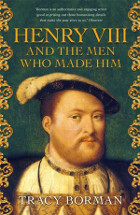Henry VIII and the men who made him by Tracy Borman

Hodder and Stoughton, 2018. ISBN 9781473649897.
(Age: Senior secondary - Adult) Recommended. Tracey Borman has
created a powerful story of the life and times of Henry VIII, King
of England from 1509 to 1547, reflecting the value of both the
historical authenticity and the collection of writings, legal and
other documents, from which Borman draws her historical narrative.
Supported throughout by numerous references, this novel describes
Henry's interactions with the men, and to a lesser extent the women
(who were really considered to be tools to producing the necessary
male heir), using historical records, and photographs of paintings
of Henry and other people important to the narrative. Additionally,
we are able to grasp the significance of the works of the writers
who have studied and documented Henry's life, particularly in the
references to the effects of the religious upheaval at that time. As
would be expected, the story is based deeply on the times and
revolutionary ideas of the Reformation in England and Borman has
created a strong sense of that period: the political, social and
religious events that brought about such great religious and social
change during Henry's lifetime.
We read how Henry was always determined to have his way, but when
thwarted, would exact violent punishment as his revenge, most often
almost immediately accomplished by killing the perpetrator, or
incarcerating those who displeased him. Reading this book in the
modern world, and knowing that so many had been 'removed' when they
upset Henry, or interfered with his plans, it seems to be remarkable
that anyone was prepared to work for him, and certainly that anyone
was prepared to challenge him. While Borman details how some of the
damned would plead their innocence, or implore forgiveness, even up
to the day of, or preceding, their 'removal', we gather that there
was almost never any chance of remission. For the men who did not do
as he demanded, or his wives, who were removed because they failed
to produce the male heir he wanted, or he had grown tired of them,
he found no reason why they should not be punished with death.
Indeed, Henry's cold and dispassionate slaughtering of those who did
not do, or produce, what he wanted, is the most abiding theme
throughout this magnificently researched tome.
Plunged into Borman's vibrant world of political intrigue, we see
the rivalry of the men who surrounded Henry, the reactions to and
change in beliefs of the new religion, and the growing antipathy, in
England, to the unsettling events of the rejection of the previously
dominant European-based Roman Catholic Church. Interestingly, it is
difficult to keep in mind that this narrative is based on truth, its
accuracy detailed in Borman's extensive bibliography, her
references, notes and index, all of which take up over sixty pages.
Captivating, commanding and beautifully written, this novel will
leave the reader with a sense of horror that this man could see
himself as above all human codes of decency in his ruling of a
country by birthright, and in his pursuit of an heir. Borman's portrayal
appears to interpret his responses, choices, actions and
interactions with others as driven by his determination to wield his
power, as he becomes the man who destroys those who displease or
disobey him. In fact, men whom he liked seem to have suffered the
same fate of needing to be killed when their actions displeased him
or when they failed to do what he demanded, even though he appeared
to be slightly saddened by this fact. This novel would be a fine
study for senior English history students and a compelling read for
anyone who is interested in this era.
Elizabeth Bondar